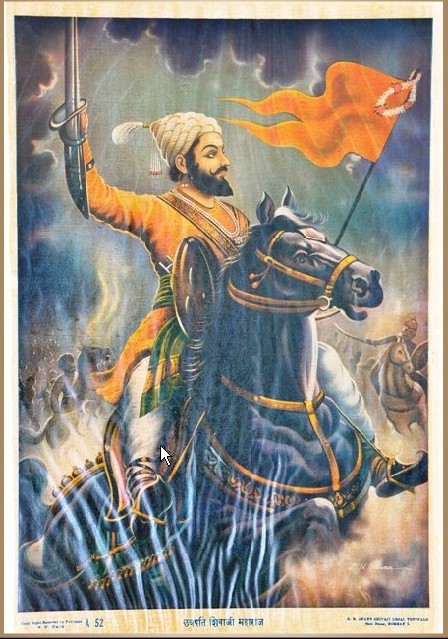CHATRAPATI SHIVAJI
1. Context
The 391st birth anniversary of Chhatrapati Shivaji Maharaj was celebrated across the country on February 19.

Source: Wikicommons
2. Key points
- For a long time in history, before air power took centre stage in military tactics and strategy, forts were crucial to the defence of any country.
- They acted as a force multiplier for the defender and a safe refuge for civilians often the first casualties of war.
- Nowhere is this more apparent than in the Maratha Countryside forts of all sizes and shapes dot the landscape.
- In their heyday, control of these forts translated into control of the territory.
- Chhatrapati Shivaji Maharaj, at the time of his death, is said to have control of over 200 forts across his territories with some estimates putting the number over 300.
- In many ways, the Marathas took fort-building to its zenith, not only building forts capable of surviving long sieges and battles but putting special attention to their placement and locations.
- Grant Duff, a soldier of the East India Company and the first comprehensive historian of the Marathas wrote: "There is probably no stronger country in the world than the Deccan from the military defence point of view".
3. The terrain of the Maratha Country
- Unlike the plains of Northern India, suited to conventional battle with large standing armies, the terrain of the Maratha country was different.
- With the Arabian Sea on one side, the Konkan plains in the centre and the Western Ghats overlooking the plains, in the 17th century much of the region was covered in thick jungles.
- Warfare in such terrain is qualitatively different, with large conventional armies prone to getting bogged down.
- Thus, as Shivaji began to consolidate and expand his influence in the region, his strategies evolved to be significantly different from the common military doctrine of the time.
- Crucial to his military strategy were hill forts.
4. A native of hill forts
- Historian Gunakar Muley called Shivaji "a fort-native".
- The Maratha icon was born and raised in the hill fort of Shivneri (around 100km from Pune), given to his grandfather by the Sultan of Ahmadnagar instead of his services as a military commander.
- Shivneri is a typical hill fort found in the Western Ghats a small but strong fortification, a top hill overlooking the surrounding terrain.
- It had a permanent source of water inside in the form of two freshwater springs and according to some accounts (to be taken with a pinch of salt), the fort was well-stocked to feed its residents for seven years.
| In "Sivaji and the Rise of the Mahrattas" by Richard Temple, M.G. Ranade, G.S. Sardesai, R.M. Netham and James Douglas and Shivneri is described as the following: "You will see what a rugged precipitous place this is and what a fitting spot it was for a hero to be born!". |
- Thus, growing up in the hills and valleys around Pune, Shivaji understood the salience of hill forts in controlling the land.
- Over his storied life, he captured multiple such forts, including Torna (When he was only 16), Rajgadh, Sinhagadh and Purandar.
5. Shivaji's guerilla tactics
- Shivaji's armed forces had some major limitations.
- First, he did not have the man or horsepower compared to most of his enemies, especially during the early stages of his life.
- Second, he was heavily reliant on obtaining supplies such as muskets and gunpowder from the Europeans, mainly the Portuguese.
- This meant that in conventional battle, he would have seldom stood a chance against his foes.
- Thus, Shivaji adopted guerilla tactics: his men would travel in small, highly mobile and heavily armed attachments, wreak havoc in the often sluggish Mughal or Adil Shahi armies, loot supplies and treasure and quickly retreat.
- Crucial to such plans were hill forts. Marathas forces would strike quickly and retreat to the many hill forts of the region.
- These forts were designed such that the approach to them was tricky, often treacherous, to large groups of men.
- Consequently, these were perfect defensive positions where either the bigger armies would not bother to attack or would have to sacrifice their strength in numbers if they did choose to attack.
| Hill forts also were constructed such that they were perfect vantage points to keep a lookout for any threat. "There should not be a higher point near the fort amongst the surrounding hills," wrote Ramchandrra Pant Amatya, Shivaji's Finance Minister. |
- Often, if there were higher points nearby, smaller forts would be constructed there.
- This can be seen in the case of the Purandar fort, which is flanked by the smaller Vajragad fort.
6. Creating an empire with the help of hill forts
- What hill forts effectively allowed Shivaji to do was project his power, beyond what would have been possible through conventional means.
- The relative safety of his forts allowed him to successfully carry his lighting tactics while fighting formidable enemies.
- As his territories grew, these forts became all the more important, as local strongholds and seats of local administration.
- From forts nestled atop great heights, he could govern the land around. They also became symbols that projected his power and presence.
- The Maratha Empire emerged from humble beginnings. While a variety of factors, concerning both the Marathas and their rivals, contributed to their rise, the significance of hill forts cannot be overlooked.
For Prelims & Mains
|
For Prelims: Chhatrapati Shivaji, Maratha Empire, Guerilla Tactics, Mughal Empire
For Mains:
1. Why were forts so important for the consolidation of the Maratha Empire? discuss the uniqueness of these forts. (250 Words)
|
Source: The Indian Express




